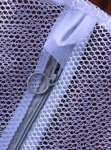- Nov 12, 2017
- 11,907
- Pool Size
- 12300
- Surface
- Plaster
- Chlorine
- Salt Water Generator
- SWG Type
- Pentair Intellichlor IC-40
The OXO cup is holding up fine, I've even walked away and come back quite a bit later to a little bit of MA left in the bottom and it's fine. Most plastic is OK for MA, but some are better than others. I researched that a bit, when I was on the squirt bottle adventure (yep, that's in the thread, too). I found the chemical name for the best plastic to use on a chemist supply website. But there's usually no way to determine what something you buy elsewhere is actually made of. What I concluded, and why I settled on the MA-adding-scheme I did, is that trying to find an alternate long-term container for MA would be risky, without knowing exactly what kind of plastic it is made of. So best to keep it stored in the plastic in which it was purchased. "Lesser" plastics for the short-term measuring and pouring pose virtually no risk, especially if you do all that over the pool water. Which is the other reason I recommend not filling a measuring cup elsewhere and carrying that across your deck. And the "why" for the bucket. Mostly all overkill, but "an ounce of prevention..."
Dang it Dirk - you're making me want to skip ahead! I won't (but I want to).
Since I'm buying the BBB measuring cups today - I assume that they held up to the acid? How does one know if a plastic will hold up to m.a.?
Dirk .... as I'm typing, I just got notice of your recent addition to this thread.
"I'm going to go back to BBB and get one more than I need, too! I like it so much, and it is so perfect for how I use it, I want a spare in case I step on it or something, only to find out later that OXO has discontinued it, or changed its design or china-cheaped-it-out, like they tend to do.
But that's just me. Sometimes when I find the perfect thing, or the perfect fit, or whatever, I can't help myself, I'll go buy more of it/them, just so I'll never be without. Just one of my many burdens..."
We do live in parallel universes ...
York



